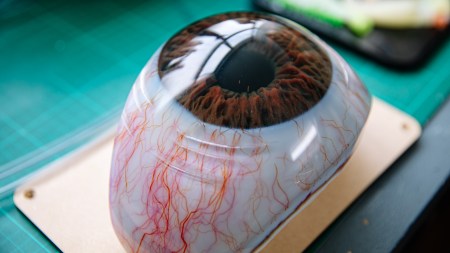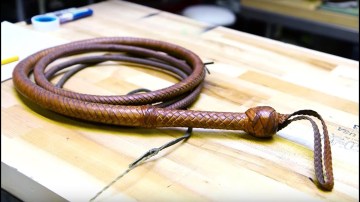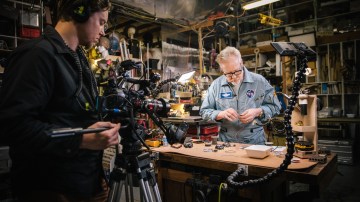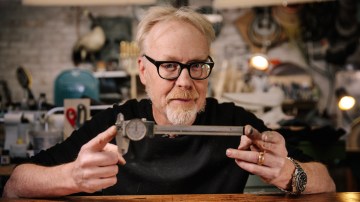Building a Custom Arcade Cabinet, Part 6
With the frame of the arcade cabinet constructed, Norm and Wes head back to the garage to begin the wiring of the buttons and other electronics. In this episode, we discuss the different types of custom arcade controls, the hardware to link them all together, and the tiny computer we’re going to build to run the software. (This video series was brought to you by Premium memberships on Tested. Learn more about how you can support us by joining the Tested Premium community!)
Camera operator: Benito Gonzalez
Editor: Benito Gonzalez
Music Library provided by Jingle Punks
28 thoughts on “Building a Custom Arcade Cabinet, Part 6”
Leave a Reply

One Day Builds
Adam Savage’s One Day Builds: Life-Size Velocirapt…
Adam embarks on one of his most ambitious builds yet: fulfil…

Show And Tell
Adam Savage’s King George Costume!
Adam recently completed a build of the royal St. Edwards cro…
All Eyes On Perserverance – This is Only a Test 58…
We get excited for the Perserverance rover Mars landing happening later today in this week's episode. Jeremy finally watches In and Of Itself, we get hyped for The Last of Us casting, and try to deciper the new Chevy Bolt announcements. Plus, Kishore gets a Pelaton and we wrack our brains around reverse engineering the source code to GTA …

One Day Builds
Mandalorian Blaster Prop Replica Kit Assembly!
Adam and Norm assemble a beautifully machined replica prop k…
House of MCU – This is Only a Test 586 – 2/11/21
The gang gets together to recap their favorite bits from this past weekend's Superb Owl, including the new camera tech used for the broadcast and the best chicken wing recipes. Kishore shares tips for streamlining your streaming services, and Will guests this week to dive into the mind-bending implications of the latest WandaVision episod…

One Day Builds
Adam Savage’s One Day Builds: Royal Crown of Engla…
One of the ways Adam has been getting through lockdown has b…

Making
Adam Savage Tests the AIR Active Filtration Helmet…
Adam unboxes and performs a quick test of this novel new hel…

Making
Weta Workshop’s 3D-Printed Giant Eyeballs!
When Adam visited Weta Workshop early last year, he stopped …

One Day Builds
Adam Savage’s One Day Builds: Wire Storage Solutio…
Adam tackles a shop shelf build that he's been putting off f…

Show And Tell
Mechanical Dragonfly Automata Kit Build and Review
Time for a model kit build! This steampunk-inspired mechanic…


























Looking good Norm surprised how small it looks I thought it was going to be a monster, I’m also surprised you didn’t go with perspex tops to your button banks to make them super slick, going to get a little hand rubbing from the ply.
Also if you’d put the cabinet on some chairs for button installation you would have had to spend half your day crouching on the floor.
Sweet!
Hey ,
Just wondering what you’re going to do with the glass as it looks like it won’t be able to sit flush with the cabinet top due to the screen bezel?
I’m guessing you’ll simply place some clear rubber feet around edges to give the glass some clearance? An option you may or may not have thought of would be to ditch the screen bezel entirely and spray the underside of glass with black paint (after masking off a screen shaped area to align with the monitor of course)? This would look pretty slick (kinda like the table tops in Star Trek TNG) and allow you to have your glass nice and flush. 🙂
Great work on the cabinet so far guys. I’ve been wanting to build a stand up cabinet for years but never get round to it.
Always be testing! 🙂
I can’t watch this, the camera work is atrocious.
I don’t care how the camera work is. I am just along for the ride; enjoying every minute of this Mame cabinet build..
Nice one.
Nice rat’s nest of wiring ! Though frankly mine would be at least as messy, if not worse, and the wires wouldn’t have been nicely labelled!
I think the theory would be to mount the ipac in an accessible location on the case, then route the wires neatly round to it, but you know, whatever works…
Thanks for sharing these videos – it’s been a good follow along.
Shame the ipac doesn’t use pluggable terminal blocks… think would have made a wiring easier and neater.
Also a complete MAME set must be around 400Gb these days.
It could be better. Who is Benito Gonzalez?
Hey A friendly bit of advice for when you are using crimps. On the pair of crimping pliers you will see three different coloured dots corresponding with three different sized holes. The colour of the dot corresponds with the colour of the crimp you are using. I noticed that on the first one you used the hole for the yellow crimp. The next time you are using them on a project try to use the right slot to ensure you get the correct amount of pressure on the joint. As for the rest of the cabinet I think it looks great. I’m considering building one of my own. One of my friends used to have one and we would spend the school holidays playing packman .
I’m with you on that! the entire “sign out” was out of focus…. I know it is trendy to have that narrow depth of field but if you can’t keep the subject in focus it is really distracting.
Lincoln Force represent!
Those skrews holding the spinner in have very little wood to grip. Wood skrews, unlike machine skrews, are tapered to a point at the end, so the first couple milimeters have little bite. I would be weary of it just dropping out when somebody puts in too much enthusiasm.
Also If you had put in all the buttons into the prefitted boards before final assembly, you could have done all the wiring sitting down at the bench, in half the time. Throw in some actual cable trees and a propper mounting for the daughter board and you would get close to a neat job.
Don’t get me wrong, I like what you are doing and it’ll work, it just feels a bit makeshift. Very very basic cabinetry and a throw it together and hide it wiring job.
Edit: And I concur with the previous commenters. After rewatching episode 3, the drop in video quality is pronounced. Both camera movement and cutting are not on joeys level. Not unwatchable, but annoying at times.
hasn’t the point been they didn’t really know what they were up to? I like this sort of realism and not some Norm Abrams, everything-is-done-perfectly vid. This is much more likely to get me moving on a project and that kinda seems to be the MO of the site (at least the new videos): Anyone can do this stuff, just start somewhere.
I guess so. I’ll happily skip over the joinery and the rustic finish. But just longer cables and some zip ties and life becomes so much easier.
But it’s in the world and sparking discussion so on that they got.
Still lovin’ this series. Can’t wait to see the final result.
You should shield the CRT and the PC components to avoid RF interference, at least the CPU, GPU not to mention the Power supply. A good idea is to get a Spectrum analyzer and find out exactly how much RF noise/interference you are dealing with. Also get a data sheet which displays the ripple and noise for the Power supply, or have it measured so you don’t get a nasty surprise 3 months down the line.
Where’s part 7?
While we´re waiting for the next part, i found this little gem of a build, Sorry the text is in swedish but it’s so cool i just had to share it with you guys. Here´s a dude who built his own virtual pinball machine.
http://www.sweclockers.com/galleri/6710-virtual-pinball-hemmabygge
Edit:
Btw, the same dude also built an arcade machine before the pinball machine.
http://www.sweclockers.com/galleri/5758-arkad-hemmabygge
Waiting for part 7 is driving me insane. I NEED CLOSURE.
Where is part 7?!
So I’m guessing things didn’t go well in the final step. Ouch I thought this was going to work but I’m sorry it didn’t.
What did happen to part 7. Even if it didn’t work I’d love to see a recap so that I don’t make the same mistakes.
wow!love the pinball. I’ve been interested in trying to make a pinball machine but gave up cause of the difficulty in maintenance and the toy connections/operations. I love this solution, so simple and elegant If I ever get the space I’ll definitely be putting one of these together for the games room.
Translation of some of the text:
“Building an arcade machine got my appetite whetted. Time for a new crazy project
Visual Pinball is a pinball simulator and is (to my knowledge) the only one that emulates roms from real, actual pinball machines. The program that handles the rom files is called PinMAME and it controls everything from when lights should blink, to the score board. Almost all pinball machines since the 90’s has a graphical score board, a so-called DMD (dot matrix display).
You have to design the play field yourself. Luckily, there are lots of skilled people nice enough to post their designed play fields on forums like for examplehttp://www.vpforums.org
An additional detail that some talented programmer has put together is the script for LedWIZ. With this you can route virtually anything that happens on the play field to the contoller card, such as blinking lights, strobe lights, shakers or replay knocker. The only thing that sets the limit is your own imagination. If the controller card can’t handle the load (max 500mA) you can simply add a relay.
So far i have installed replay knocker, servo motor, strobe light, a shaker, 5 contactors and 5 led flashers
-Update march 2013:
Servo, strobe and shaker disconnected due to “too much of the goodies”. Only contactors, knocker and shaker are connected.
I have chosen to use three screens (play field 46″, back box 32″ and DMD 19″)
The measurements are taken from a real pinball machine, Twilight Zone (Williams Wide body) and to make room for as much play area as possible, i have disected the LCD’s and removed all unnecessary parts
Thanks for the links. Will have to add this to the backlog down the track. But I adore the set up and Table editor. Hopefully on 3 years time when I finally get to this I’ll have the option of a glasses free 3D tv 🙂
Where indeed?
Part 7:
http://mdvip-tested.md-staging.com/art/makers/469351-building-custom-arcade-cabinet-part-7/